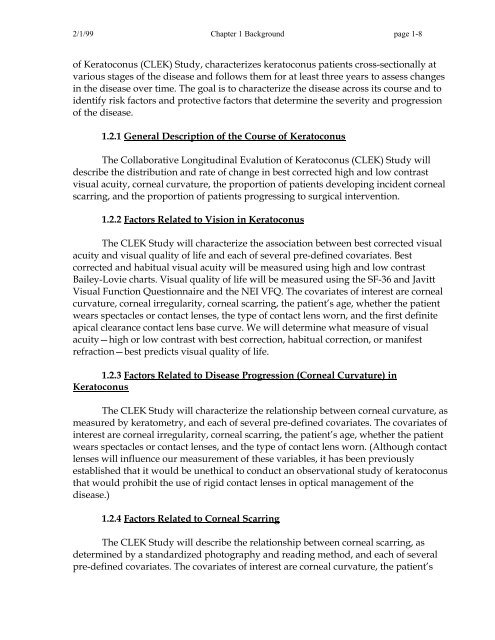OM t of c.iii - Vision Research Coordinating Center - Washington ...
OM t of c.iii - Vision Research Coordinating Center - Washington ...
OM t of c.iii - Vision Research Coordinating Center - Washington ...
You also want an ePaper? Increase the reach of your titles
YUMPU automatically turns print PDFs into web optimized ePapers that Google loves.
2/1/99 Chapter 1 Background page 1-8<br />
<strong>of</strong> Keratoconus (CLEK) Study, characterizes keratoconus patients cross-sectionally at<br />
various stages <strong>of</strong> the disease and follows them for at least three years to assess changes<br />
in the disease over time. The goal is to characterize the disease across its course and to<br />
identify risk factors and protective factors that determine the severity and progression<br />
<strong>of</strong> the disease.<br />
1.2.1 General Description <strong>of</strong> the Course <strong>of</strong> Keratoconus<br />
The Collaborative Longitudinal Evalution <strong>of</strong> Keratoconus (CLEK) Study will<br />
describe the distribution and rate <strong>of</strong> change in best corrected high and low contrast<br />
visual acuity, corneal curvature, the proportion <strong>of</strong> patients developing incident corneal<br />
scarring, and the proportion <strong>of</strong> patients progressing to surgical intervention.<br />
1.2.2 Factors Related to <strong>Vision</strong> in Keratoconus<br />
The CLEK Study will characterize the association between best corrected visual<br />
acuity and visual quality <strong>of</strong> life and each <strong>of</strong> several pre-defined covariates. Best<br />
corrected and habitual visual acuity will be measured using high and low contrast<br />
Bailey-Lovie charts. Visual quality <strong>of</strong> life will be measured using the SF-36 and Javitt<br />
Visual Function Questionnaire and the NEI VFQ. The covariates <strong>of</strong> interest are corneal<br />
curvature, corneal irregularity, corneal scarring, the patient’s age, whether the patient<br />
wears spectacles or contact lenses, the type <strong>of</strong> contact lens worn, and the first definite<br />
apical clearance contact lens base curve. We will determine what measure <strong>of</strong> visual<br />
acuity—high or low contrast with best correction, habitual correction, or manifest<br />
refraction—best predicts visual quality <strong>of</strong> life.<br />
1.2.3 Factors Related to Disease Progression (Corneal Curvature) in<br />
Keratoconus<br />
The CLEK Study will characterize the relationship between corneal curvature, as<br />
measured by keratometry, and each <strong>of</strong> several pre-defined covariates. The covariates <strong>of</strong><br />
interest are corneal irregularity, corneal scarring, the patient’s age, whether the patient<br />
wears spectacles or contact lenses, and the type <strong>of</strong> contact lens worn. (Although contact<br />
lenses will influence our measurement <strong>of</strong> these variables, it has been previously<br />
established that it would be unethical to conduct an observational study <strong>of</strong> keratoconus<br />
that would prohibit the use <strong>of</strong> rigid contact lenses in optical management <strong>of</strong> the<br />
disease.)<br />
1.2.4 Factors Related to Corneal Scarring<br />
The CLEK Study will describe the relationship between corneal scarring, as<br />
determined by a standardized photography and reading method, and each <strong>of</strong> several<br />
pre-defined covariates. The covariates <strong>of</strong> interest are corneal curvature, the patient’s
















